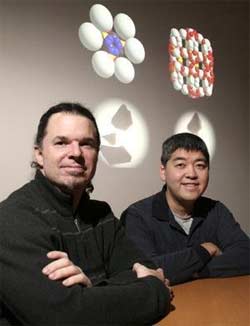A new process for catching gas from the environment and holding it indefinitely in molecular-sized containers has been developed by a team of University of Calgary researchers, who say it represents a novel method of gas storage that could yield benefits for capturing, storing and transporting gases more safely and efficiently.
"This is a proof of concept that represents an entirely new way of storing gas, not just improving on a method that already exists," said U of C chemistry professor George Shimizu. "We have come up with a material that mechanically traps gas at high densities without having to use high pressures, which require special storage tanks and generate safety concerns."
In a new article in Nature-Materials,* Shimizu, fellow U of C professor David Cramb, chemistry graduate student Brett Chandler and colleagues from the National Research Council describe their invention of "molecular nanovalves." Using the orderly crystal structure of a barium organotrisulfonate, the researchers developed a unique solid structure that is able to convert from a series of open channels to a collection of air-tight chambers.
The transition happens quickly and is controlled simply by heating the material to close the nanovalves, then adding water to the substance to re-open them and release the trapped gas. The paper includes video footage of the process taking place under a microscope, showing gas bubbles escaping from the crystals with the introduction of water.
"The process is highly controllable and because we're not breaking any strong chemical bonds, the material is completely recyclable and can be used indefinitely," Shimizu said.
The team intends to continue developing the nanovalve concept by trying to create similar structures using lighter chemicals such as sodium and lithium and structures that are capable of capturing the lightest and smallest of all gases -- hydrogen and helium.
"These materials could help push forward the development of hydrogen fuel cells and the creation of filters to catch and store gases like CO2 or hydrogen sulfide from industrial operations in Alberta," Cramb said.

